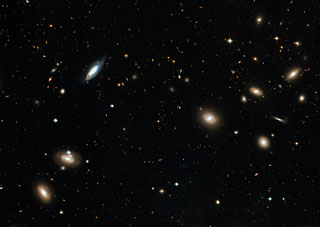Hubble’s Advanced Camera for Surveys has observed a large portion of the Coma Cluster, stretching across several million light-years. The entire cluster is more than 20 million light-years in diameter, is nearly spherical in shape and contains thousands of galaxies.
Also known as Abell 1656, the Coma Cluster is over 300 million light-years away. The cluster, named after its parent constellation Coma Berenices, is near the Milky Way’s north pole. This places the Coma Cluster in an area that is not obscured by dust and gas from the plane of the Milky Way, and so is easily visible to observers here on Earth.
Most of the galaxies that inhabit the central portion of the Coma Cluster are elliptical galaxies. These apparently featureless “fuzz-balls” are a pale golden brown in colour and contain populations of old stars. Both dwarf and giant ellipticals are found in abundance in the Coma Cluster.
Farther out from the centre of the cluster there are several spiral galaxies. These galaxies contain clouds of cold gas that are giving birth to new stars. Spiral arms and dust lanes “accessorise” these bright bluish-white galaxies, which have a distinctive disc structure.

Abel 1656 (Coma Cluster) – Click for 1280×909 image
More: here, here
No comments:
Post a Comment
Note: Only a member of this blog may post a comment.